The following article is the culmination of the Brotherhood’s intelligence reports on the organization introduced prior to the Thirteenth Great Jedi War that call themselves the The Severian Principate.
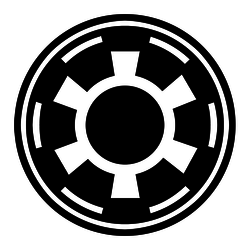
|
| The Severian Principate
|
|
Lucian Niatinus
|
|
The Triumvirate
|
|
Sirmium
|
- Mid-Rim
- Kastolar and Essaga sectors
|
|
18 BBY
|
|
|
|
The Brotherhood
|
History
Early History & Contact With The Brotherhood
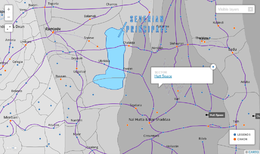 Territories of the Principate
Territories of the Principate
The Severian Principate is a rare Imperial Warlord state which not only endured but thrived following the Empire’s collapse. Originally a network of mining worlds and orbital facilities in the Kastolar Sector, it existed to fuel the Empire’s war machine. This changed with the governorship of Lucian Niatinus, a commander disillusioned with the Emperor’s self-destructive policies. Devoted to improving the lives of his citizens and secretly allying with the smugglers and pirates from the nearby Hutt Space, he sought to create an ordered state free of the tyranny which inspired the Rebellion.
Niatinus was one of the first Warlords to declare independence following Palpatine’s death. Culling the ranks of those hidebound by COMPNOR dogma, he took the first steps to abolish slavery within his territories and gave former serfs a voice in his new government. Through the promise of protection and trade deals, the Principate was able to quickly encompass nearby systems and expand its commerce to Hutt Space and the Core.
Despite its early successes, the Severian Principate was soon forced to merge with the New Republic when threatened by rival Warlords. Their acceptance required Niatinus to step down, but allowed the Principate to retain much of its autonomy. Under New Republic rule, the Principate instead opted to expand through trade. As worlds recovered from the war, it was able to use its facilities to establish itself as a commercial empire in the eastern Outer-Rim. Nevertheless, the Principate was far from trusted by its allies thanks to its authoritarian policies and ability to control others through trade. The matter was only made worse by its willingness to circumvent the Military Disarmament Act through various means.
The Principate first became tangentially involved with the Dark Brotherhood shortly before 35 ABY, during an encounter with elements of the fledgling Collective. While the exact details of the meeting were unclear, they proved unwilling to assist the Collective in their planned genocide of all individuals with a substantial connection to the Force. This would remain true until two years later in 37 ABY, when the Brotherhood directly contacted the Principate with offers of an alliance. A meeting was arranged between representatives of both powers in the Lyra-3K-a system, along with a number of figures representing the Collective after they approached the Triumvirate once more. This proved to be a trap, as the Collective initiated a false flag attack on the nearby colony, attempting to frame the Brotherhood for a surprise attack and dissuade the Principate from forming any links with the group.
The Lyra system quickly became a battleground between forces from all three sides, as Brotherhood ships were drawn into the fighting and various Principate flights were coerced into joining the Collective in initiating a counterattack. The initial clans attempted to follow their own agendas during this battle, with some seeking to limit the collateral damage of the fighting, while others viewed it as a financial opportunity. Yet, by the end, the Principate turned on the Collective after being convinced of the Brotherhood's innocence in the matter. Forcing its rogue units to stand down, they were able to drive the Collective from the system and form a preliminary alliance with the Brotherhood beginning with an open exchange of information. What prevented this from being a total victory was the capture of the Brotherhood's representatives by the Collective, with Evant Taelyan among them.
Several months into the newfound alliance, the Principate soon discovered how problematic of an enemy the Collective could be. Seeking to rescue prisoners taken in the prior conflict, the Collective initiated a massive riot on Tenixir, a hidden prison complex where the Principate held its worst offenders. The Brotherhood was brought in to quell the fighting and restore order, succeeding in doing so thanks to inside assistance. A large group of inmates supported the Brotherhood out of a sense of self-preservation, led by the former pirate Rasha Hawee. The Collective succeeded in freeing a small number of scientists, but failed in its overall goal. Due to an ongoing prisoner transfer between the Principate and Brotherhood, the inmates who suppressed the riot were brought into Brotherhood space and granted their freedom. Those that displayed relative usefulness were recruited into the Shroud Syndicate. Those that remained independent largely gathered into a group called The Tenixir Revenants with Hawee as their leader. Although nominally aligned with the Brotherhood, the Revenants regarded both the Principate and Collective with extreme hostility.
The alliance with the Brotherhood would later see Severian reinforcements intervening at Arx, where they helped to repel the Collective assault during the Fourteenth Great Jedi War.
Tenixir Conflict & Escalation
In the wake of the attack on Arx, the Principate began expanding its operations to a number of surrounding systems. Establishing a number of new mining outposts on more distant worlds, its leaders began hunting for the mysterious yet powerful crystals that had gained interest among their allies and enemies alike. Guarded by the First fleet, they uncovered one such crystal on the fifth Moon of Jumarrot, and a chance encounter with the Revenants at several dig sites confirmed that the former criminals were similarly hunting for the crystals. During these operations, Triumvirs Xarel and Freewoman began discussing plans among themselves, without consulting the third of their number, Vairya Muktiba. Each began laying down plans for improved order and security, opting not to involve the Triumvir of Oaths in their schemes.
The extent of Xarel and Freewoman's ambitions became clear when they pushed to emulate the Collective, forging their own augmented troopers by integrating them into the recovered crystals. As Muktiba formed a party within the Senate, the Imperial Harmony Party, attempting to push a more moderate approach along with making peace with the Revenants, a split emerged within the Principate. With Xarel and Freewoman's Restorers attempting to forcibly emulate the Galactic Empire by pushing for a more militant effort to expand their sphere of influence on one side, and the Harmonists believing that such methods were extreme beyond sanity and attempting to limit their already overstretched fleets, it became a flashpoint of conflict ready to boil over.
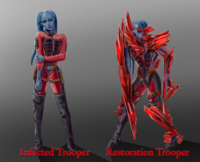 An example of a Restoration Trooper.
An example of a Restoration Trooper. Unknown to any involved at the time, this split had been cultivated by a mysterious Seer that had been actively manipulating all sides involved. With the Revenants caught in a similar internal conflict, she awaited to use the Hutts as a means to spark full-scale war. As they were drawn to the planet of Dandoran in a public auction, the reveal of various crystals up for purchase resulted in a firefight between representatives. It was unknown who fired first, and soon it did not matter, with the more militant elements of both the Revenants and Principate using it as an excuse to initiate open war. Both sides began calling upon the Brotherhood for assistance, resulting in the newly ascended Darth Nehalem opting to favour neither side. Brotherhood members were instead permitted to act individually, supporting whichever faction they favoured, so long as they did not actively engage other Brotherhood elements. The conflict was used as a Rite of Supremacy, resulting in the Rite of Supremacy: Escalation event.
Much of the fighting was focused upon Tipool City, where the auction had been initiated. Muktiba had been within the city during the battle's beginning, with Xarel examining an abandoned Imperial outpost several kilometres away. Although Muktiba's forces attempted to limit collateral damage and willingly took prisoners for a considerable time, Xarel's return saw an insistence for more radical opposition. Even with their limited military elements, the Principate had a number of key advantages, which were soon bolstered by the arrival of Freewoman and the Restoration Troopers. Wasting no time, the Restorers deployed their units in a massed attack against the Revenants entrenched within the city, without regard for civilian casualties. Mindless, destructive, and with their bodies warped by the crystals they had been infused with, Muktiba was horrified to the point of pulling a blaster on her fellow Triumvirs. Although they were not killed, Freewoman and Xarel were forced to flee.
At the height of the battle, the Seer made her move, and arrived in person with a small honour guard. Assisted by a being similar in nature to the Restoration Troopers, the Seer utilised an unknown means to turn them to her side, utilising them as a means to slaughter Principate and Revenants alike. Freewoman was among those slaughtered by the Troopers, as the two Triumvirs attempted to escape along with those still loyal to them. As the Seer turned to leave, having turned Avitus Oligard (the Revenants' secret benefactor) to her side, Xarel offered her services in exchange for survival. The Seer accepted, and the Triumvir departed with them.
With the more hostile elements of both sides either dead or unable to voice their views, Muktiba was able to meet with Zyft Yadar, leader of the Revenants' Expansionist faction. Having undergone a similar ideological split, the Expansionists had sought to establish their own dominion in the Outer Rim while those they opposed wished only for revenge against the Principate. Although there was no love lost between the two powers, they were able to settle upon a ceasefire. Although bloodied by the battle, it nevertheless brought their current conflict to a swift end.
Muktiba's leadership would shift the Principate's stance to a far more peaceful footing, pushing through multiple reforms to reverse the actions of the other former Triumvirs. Although beneficial, a mass disarmament action significantly reduced the Principate's standing as a military power, and would leave them unable to support the Brotherhood in the Fifteenth Great Jedi War.
Harmonist Rule
Thanks to the loss of two Triumvirates and the outcome of the conflict on Dandoran, the Principate underwent a substantial restructuring thanks to the dominance of the Harmonist factions. Vastly reworking the Principate into a different ideological direction, the group actively diminished in strength, selling off its previous warships to the Brotherhood. This left its military reduced from eight to three fleets by 41 ABY, and cost the bulk of its previous defensive capabilities. To replaced those who has respectively died and betrayed the Principate, Valis Rendeshi and Jacinta Ni’Erilia were elevated to the rank of Triumvir, and were given the task of converting the remaining military fleet into humanitarian vessels.
Despite its loss of ability to defend its borders, a growing number of systems which had survived the chaos of the New Republic's fall were opting to join the Principate, and asked for acceptance into the government. This left the Principate leaning heavily upon the Brotherhood for any kind of meaningful protection, and placed them in a subservient role to the Sith government.
Organization
Governmental Systems and Structure
The Severian Principate is governed by a small elite trio of leaders, selected from the highest-ranking members of their respective fields: Galactic Diplomacy, Industry, and Social Administration. These form the Triumvirate, which serves as a head of state and oversees the development of the Principate on a grand scale. While successors can be elected, the role was ultimately seen as a natural final step in a successful career.
Day-to-day decisions are handled by the Senate, formed from elected representatives of each planet within Principate space. Issues of policy and judicial alterations are handled by a smaller Parliament, the members of who are selected from a second group of system representatives. Protectorate states are not permitted seats on either council until they accept full integration into the Principate. How much this has changed thanks to Harmonist rule remains unclear.
The Triumvirate
| Leaders of the Severian Principate
|
| Vairya Muktiba
|
Adlez Freewoman (K.I.A.)
|
Kamlin Xarel (M.I.A.)
|
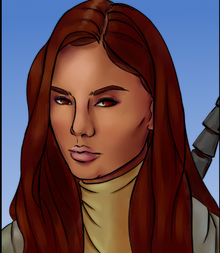
|
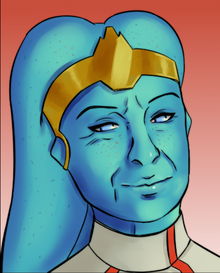
|
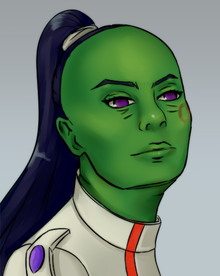
|
The current triumvirate leaders are as follows:
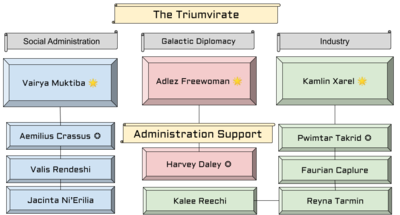 Triumvirate staff organization chart
Triumvirate staff organization chart
The Council of Systems
Each of the Principates allied systems has their representative leader sit on the Council of Systems, a body much like a senate. They represent the needs of their systems to work along side the Triumvirate in assuring a peaceful and prosperous life for all within the Principate's boarders. This council has grown from the original seven systems, and four protectorates to include the additional five new systems that joined in recent years.
Culture and Territories
The Severian Principate’s original territories cover seven populated systems and four protectorates, with its capital based on the ocean planet of Sirmium. Situated between Hutt Space and the Core worlds, it can rapidly transport ships to and from the Outer-Rim. This has been further assisted by the alliance with trader, smuggler and pirate factions, some of which have settled within the Principate’s borders. Most core worlds are barren mining planets of extreme temperatures, with the more temperate worlds residing in its outlying systems.
Due to its disparate populations, the Principate is a melting pot of varied cultures. Most emulate the traditions of their homeworlds, albeit with an emphasis on order and productivity encouraged by propagandists. The collectivist ideal of everyone working their part has helped unite the varied species, focusing them upon strengthening their holdings.
Industry & Economy
Having served as a large cluster of mining worlds and spacedocks at the time of its independence, the Severian Principate has long benefitted from a strong industry. A multitude of its key worlds are rich in the likes of Nova Crystals, Tibanna gas, and Lommite.
The turmoil following the Empire’s collapse allowed the Principate to quickly establish itself as a major power within the region. Many facilities previously devoted to weapons production were repurposed for manufacturing various items for civilian use, such as agricultural machinery and communications technology. This has only expanded over time, with the Principate buying out previously domineering companies and utilising its protectorate states to bypass laws preventing industry monopolies. Controversially, the Principate has even used elements of its military as mercenary companies.
Many vessels of the Principate’s trading fleet are refitted warships purchased cheaply from deconstruction yards, with the likes of Carracks serving as sprint traders. Larger ships such as Star Destroyers operate as mobile harbours, allowing the Principate to establish stronger ties with trading partners. While each was disarmed, most were left in a state where they could be refitted with weapons in times of war.
After the events on Dandoran, the Principate significantly expanded and then refocused all efforts toward humanitarian aid and support, turning medical aid into a major output used to support failing or damaged worlds across the galaxy.
Prominent Cadres
Operating under the overall umbrella of the Severian Principate are many quasi-official organizations known as cadres. These cadres attract like-minded individuals and perform specific and often highly specialized tasks for the Severian Principate. Some of these cadres can be considered official organs of state, while others are technically illegal - if not tolerated - gangs of operatives.
Death Dealers
| Death Dealers
|
|
Severian Principate
|
|
Criminal Operations
|
|
4
|
|
Glen Phidris
|
Roster:
- Natesa Panes
- C'leo
- Tak'att'yvun
The Death Dealers are a self styled minor "gang" under the larger Hutt Cartel's reach, specifically serving under Godda the Hutt and primarily dealing in drug trade between Hutt Space and planets within the Sevarian Principate. The gang mainly sells Death Stick stock, thus the name selected by their pun-loving leader, Glen. Glen formed his little cadre with his best friend on all of Nar Shadda, a Togorian with a Chiss fetish who called himself Katty — and always insisted on others using his full Chiss name. They later recruited C'leo, one if their most loyal customers, for his slicing skills, and finally Natesa Panes, who approached them just recently as an operative from the mysterious Shroud Syndicate.
Severian Electorate Commission
| Severian Electorate Commission
|
|
Severian Principate
|
|
Political Intelligence
|
|
5
|
|
Albana Trief
|
Roster:
- Yolanda Pola
- Xerion Bland
- Lovan Remaz
- Fran Drum
At the core of the Severian Principate is the Senate. At the core of the Senate is the Severian Electorate Commission. The SEC is a sworn group of dedicated Senators who are tasked by the Triumvirate to ensure that the members who are elected to the Senate do not come with any secrets. The Commission has been granted full authority to investigate Senators and would-be Senators alike. A seat on the Commission is considered a life appointment and can only end through death.
The Commission is widely seen by many as a selection committee, choosing the candidates that member planets may vote for. Because of this, the members of the SEC are among the most corrupt in the Senate, often accepting the most lavish of gifts and bribes in exchange for their vote of confidence.
Galactic Trade Department
| Galactic Trade Department
|
|
Severian Principate
|
|
Diplomacy & Trade
|
|
4
|
|
Jonaak Clarsi
|
Roster:
- Erick Jindo
- Fae Deran
- Robert Findallisher
The Principate’s trade negotiations always tended toward the Imperial method of strong-arm and scare tactics, despite them trying to rehabilitate their image. After they joined the New Republic, they needed to change their primary form of trade negotiations to keep things on the up-and-up. They did this on the surface. Project Black is an on-the-books department of International Diplomacy, which, on paper, serves a support team, but in actuality is the true source of all negotiations. They don’t have true signing authority, but no deal gets done without the sign off of Jonaak Clarsi.
Within the Galactic Trade Department resides Project Black. Project Black operates as a top-down organization of negotiators who are all handpicked by the Triumvirate. They are cut-throat and end up giving the Principate an edge in all financial endeavours that are undertaken. Failure to provide favorable deals results in a removal from Project Black, and all NDAs signed by its members are unofficially punishable by death preemptively.
Military Doctrine & Formations
Formed out of whatever resources it had on hand, the military arm of the Severian Principate closely resembles that of the Empire's military, with an emphasis upon superior firepower and maintaining a numerical advantage over their enemies.
Command Structure
Unusually for a military spawned from the Empire, the Principate favors a decentralized command structure over a rigid hierarchy. As competence is prized above blind obedience, commanders are given leeway in how to achieve their goals. Officers will outline necessary objectives and risks, allowing for subordinates to take initiative within wider plans. This also allows the Principate’s forces to maintain a coherent leadership in the face of heavy casualties.
The most experienced of the Principate’s soldiers are drafted into the Lantic Council. This organisation discusses worst-case scenarios and simulates conflicts with any power from the Hutt Cartels to the Dark Jedi Brotherhood. This is then be used to form new contingency plans, while also examining how new technological developments might impact battles. How significantly the command structure, or if any part even remains following the Harmonist rule, remains unclear.
Fleet & Army Elements
The Principate's forces were originally divided into Eight main fleet groups, which combine naval and military assets into a single formation. Both closely resemble the military forces favoured by the Galactic Empire at the height of its power, and many vessels that make up the core of these groups are designs from that era. Imperial I and Imperial II class Star Destroyers make up the command vessels of these groups, with Victory I-class variants serving in a supporting role. Other sights common within these fleets include Carrack cruisers, Nebulon-B frigates, and Raider I-class corvettes. Equally, the fighter complements of these battle groups consist primarily of TIE Series variants with fighters, interceptors, and bombers being a common sight in most hangers.
However, following the civil war between groups within the Principate and the rise of the Tenixir Revenants, the entire military was effectively gutted under the command of the new Harmonists faction. Reduced to less than half of its previous strength, the remaining three groups were instead focused more toward providing humanitarian aid, selling off the bulk of their modern or even relatively powerful warships to the Brotherhood. This was treated as the start of a closer alliance between the two factions, even if it left the Principate under strength and heavily relying on the Brotherhood for aid.
The ground forces attached to each fleet follow a uniform structure, divided into seven regiments designated by an alphabetical naming structure. Each of these, in turn, consists of four battalions and four companies to each of them, ranging from line-companies to special missions groups. The vehicles used to support these companies are equally typically those most closely associated with the Empire, such as AT-ATs, AT-STs and a number of Imperial combat speeders.
Much like their war fleet, the strength of all ground forces were significantly reduced during the Harmonist rule, losing the bulk of its previous armoured firepower. However, ironically, it also saw the expansion into a full nine regiments in order to support humanitarian efforts. As part of this rebirth, the full naming structure and overall concept of the military was reworked, abandoning the Aurebesh naming system in favour of a basic numerical system for both regiments and battalions.
The Principate also briefly experimented with organic superweapons known as Restoration Troopers - Beings fused with an unknown crystal substance that massively enhanced their physical strength, durability, and sheer resilience at the cost of any free will. Although effective on the battlefield, their deployment in Tipool City saw them slaughtering civilians and hostiles without regard for any difference, and they were soon subverted by another power known as the Seer.
Every citizen of the Severian Principate undergoes several years of mandatory service within the military. This allows the Principate to rapidly expand its armies during times of war.
Foreign Association and Affairs
Hutt Clans
Early in its development, the Principate relied heavily on imports from and exports to the Hutt cartels. Many smugglers and traders found their home in the Principate as it was near enough to Hutt space. Since their merger with the New Republic, asn in more recent years, the Principate has officially moved away from the Hutts. However, much of the underground trade still remains intact.
New Republic
While a nominally a member of the New Republic, diplomatic relations between it and the Principate were often strained. The use of Imperial ideologies was decried by planets which had openly supported the Rebellion, a matter which was not helped by its expansionist policies.
Nevertheless, the Principate’s efforts to eradicate nearby slavery operations earned it allies, and likes of Kashyyyk and Alzoc III remain on positive terms as many families originated from those worlds. Equally, the Principate’s strong industry was essential in allowing multiple worlds to recover from Imperial occupation, which permitted it a more positive reputation among minor Mid-Rim powers.
Galactic Empire & First Order
At best, the Principate’s citizens view the Empire as a grand concept poisoned by the megalomania of its rulers. While the Principate utilised its ideals of order and control as its foundations, the Empire is regarded as a blight that the galaxy is better without.
Yet while the Empire is viewed with bitter disdain, the First Order is regarded with absolute contempt. Deemed a collection of old monsters who escaped justice and young fools that fetishized tyranny, the Principate saw the First Order as its dark mirror: a government which did not learn from the Empire’s atrocities but instead came to venerate them. This view has not changed, even following the collapse of the First Order and later the Final Order.
The Collective
Despite the distrust the Severian Principate leadership has towards Force Users given their history with the Empire, it regards the Collective as a pressing threat. This stems from an attempted coup by the Collective, to turn the Principate into a source of new recruits to use against the Brotherhood.
Original concept by:
- Ka Tarvitz, #14751 - Writer, Proofreader, Researcher
- Alethia Archenksova, #14287 - Editor, Proofreader, Character Creator
- Aurora “Aura” Ta’var, #10388 - Writer, Character Creator
Changes during the Harmonist government by: